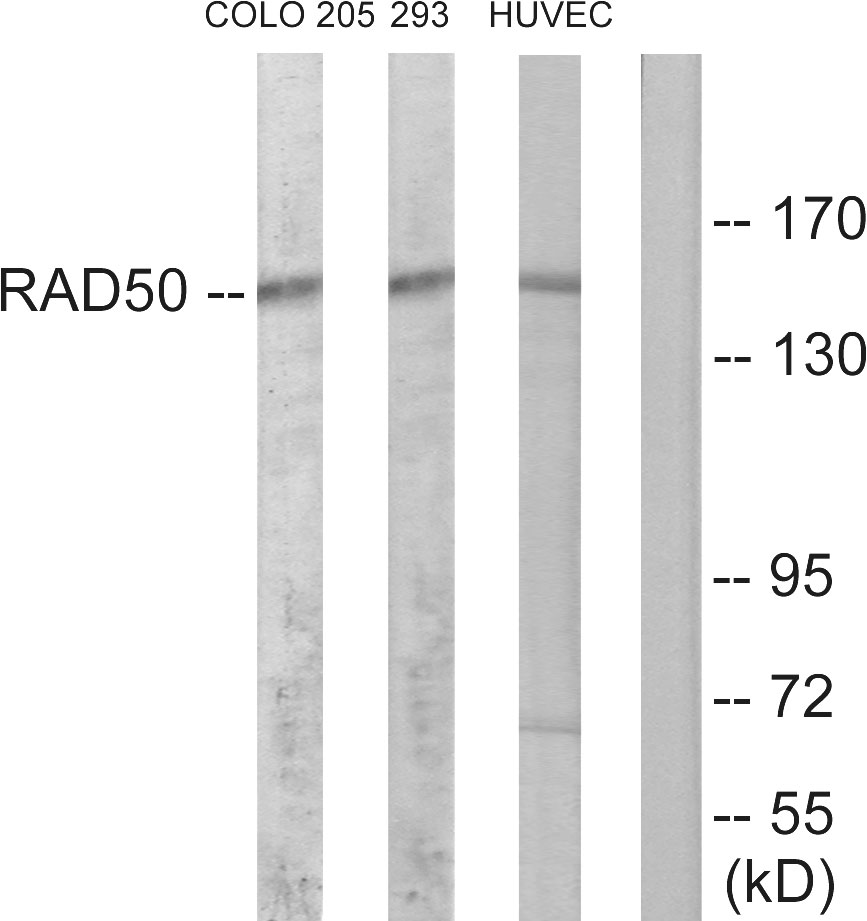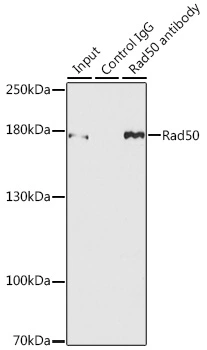Rad50 antibody [13B3]
GTX70228
ApplicationsImmunoFluorescence, ImmunoPrecipitation, Western Blot, ChIP Chromatin ImmunoPrecipitation, ImmunoCytoChemistry, ImmunoHistoChemistry, ImmunoHistoChemistry Paraffin, Other Application
Product group Antibodies
ReactivityHuman, Monkey, Mouse, Rat
TargetRAD50
Overview
- SupplierGeneTex
- Product NameRad50 antibody [13B3]
- Delivery Days Customer9
- Application Supplier NoteWB: 1:500-1:3000. ICC/IF: 1:100-1:1000. IHC-P: 1:100-1:1000. *Optimal dilutions/concentrations should be determined by the researcher.Not tested in other applications.
- ApplicationsImmunoFluorescence, ImmunoPrecipitation, Western Blot, ChIP Chromatin ImmunoPrecipitation, ImmunoCytoChemistry, ImmunoHistoChemistry, ImmunoHistoChemistry Paraffin, Other Application
- CertificationResearch Use Only
- ClonalityMonoclonal
- Clone ID13B3
- Concentration1.7 mg/ml
- ConjugateUnconjugated
- Gene ID10111
- Target nameRAD50
- Target descriptionRAD50 double strand break repair protein
- Target synonymsNBSLD, RAD502, hRad50, DNA repair protein RAD50, RAD50 homolog, double strand break repair protein
- HostMouse
- IsotypeIgG1
- Protein IDQ92878
- Protein NameDNA repair protein RAD50
- Scientific DescriptionThe protein encoded by this gene is highly similar to Saccharomyces cerevisiae Rad50, a protein involved in DNA double-strand break repair. This protein forms a complex with MRE11 and NBS1. The protein complex binds to DNA and displays numerous enzymatic activities that are required for nonhomologous joining of DNA ends. This protein, cooperating with its partners, is important for DNA double-strand break repair, cell cycle checkpoint activation, telomere maintenance, and meiotic recombination. Knockout studies of the mouse homolog suggest this gene is essential for cell growth and viability. Mutations in this gene are the cause of Nijmegen breakage syndrome-like disorder.[provided by RefSeq, Apr 2010]
- ReactivityHuman, Monkey, Mouse, Rat
- Storage Instruction-20°C or -80°C,2°C to 8°C
- UNSPSC12352203
References
- Zhuang X, Xiao R, Fu Y, et al. MRE11:p.K464R mutation mediates olaparib resistance by enhancing DNA damage repair in HGSOC. Cell Biosci. 2023,13(1):178. doi: 10.1186/s13578-023-01117-0Read this paper
- Packard JE, Williams MR, Fromuth DP, et al. Proliferating cell nuclear antigen inhibitors block distinct stages of herpes simplex virus infection. PLoS Pathog. 2023,19(7):e1011539. doi: 10.1371/journal.ppat.1011539Read this paper
- Dullovi A, Ozgencil M, Rajvee V, et al. Microtubule-associated proteins MAP7 and MAP7D1 promote DNA double-strand break repair in the G1 cell cycle phase. iScience. 2023,26(3):106107. doi: 10.1016/j.isci.2023.106107Read this paper
- Sigismondo G, Arseni L, Palacio-Escat N, et al. Multi-layered chromatin proteomics identifies cell vulnerabilities in DNA repair. Nucleic Acids Res. 2023,51(2):687-711. doi: 10.1093/nar/gkac1264Read this paper
- Belmonte-Fernández A, Herrero-Ruíz J, Galindo-Moreno M, et al. Cisplatin-induced cell death increases the degradation of the MRE11-RAD50-NBS1 complex through the autophagy/lysosomal pathway. Cell Death Differ. 2023,30(2):488-499. doi: 10.1038/s41418-022-01100-1Read this paper
- Price AM, Steinbock RT, Lauman R, et al. Novel viral splicing events and open reading frames revealed by long-read direct RNA sequencing of adenovirus transcripts. PLoS Pathog. 2022,18(9):e1010797. doi: 10.1371/journal.ppat.1010797Read this paper
- Xiao H, Li F, Mladenov E, et al. Increased Resection at DSBs in G(2)-Phase Is a Unique Phenotype Associated with DNA-PKcs Defects That Is Not Shared by Other Factors of c-NHEJ. Cells. 2022,11(13). doi: 10.3390/cells11132099Read this paper
- Boddin J, Ip WH, Wilkens B, et al. A Single Amino Acid Switch in the Adenoviral DNA Binding Protein Abrogates Replication Center Formation and Productive Viral Infection. mBio. 2022,13(2):e0014422. doi: 10.1128/mbio.00144-22Read this paper
- Price AM, Steinbock RT, Di C, et al. Adenovirus prevents dsRNA formation by promoting efficient splicing of viral RNA. Nucleic Acids Res. 2022,50(3):1201-1220. doi: 10.1093/nar/gkab896Read this paper
- Ko JMY, Lam SY, Ning L, et al. RAD50 Loss of Function Variants in the Zinc Hook Domain Associated with Higher Risk of Familial Esophageal Squamous Cell Carcinoma. Cancers (Basel). 2021,13(18). doi: 10.3390/cancers13184715Read this paper




